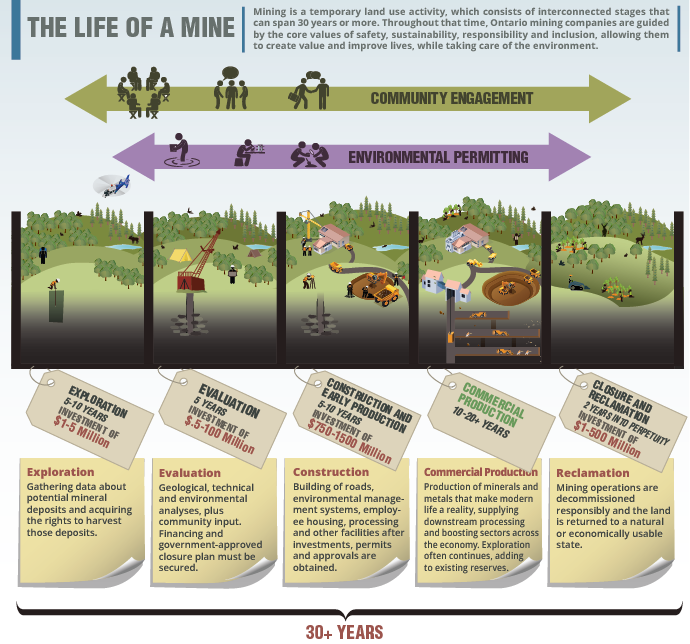Yukon Mining 101 Information Hub
Welcome to the Yukon Chamber of Mines information hub. Thank you for visiting.
Yukon Mining 101 Information Hub
Welcome to the Yukon Chamber of Mines information hub. Thank you for visiting.
Please use the navigation below to narrow your search to your item of interest.
Mining Life Cycle
The mining life cycle typically involves five key stages: Prospecting, Exploration, Planning and Evaluation (Assessment, Permitting and Licensing), Construction, Production (Operations) and Reclamation and Closure. These stages represent the progression from initial discovery to the closure of a mine site.
Although the addition of even one operating mine can bring substantial benefits to the territory, success does not come quickly or easily. It takes a great deal of will, effort and time to discover a viable deposit and bring it to production.
There is no way of predicting where a profitable deposit will be found. Each prospector and investor may fervently hope for the next “big find”, however: only 1 in 10 mineral exploration projects are taken to the drill stage; 1 in 1000 of those drill programs reveal viable mineral deposits; and, ultimately less than 1 in 10,000 projects become mines. It is typically taking 10 to 15 years of consultation, exploration, data analysis, planning and financing to bring a mine into production.

Image: Government of Ontario
Progressive Reclamation
Mining provides the metals and critical minerals we need for our society to function and the mines of today, through Progressive Reclamation (also known as Rehabilitation), plan for post-closure activities during the entire mining process from start to finish.

Image: Visual Capitalist
Assessment and Permitting
The Yukon’s stringent regulatory environment, combined with the industry’s commitment to responsible practices and its proactive approach to the use of new technologies, prioritizes public health, public safety, Indigenous values, rights and title and the environment.
The Yukon Environmental and Socio-economic Assessment Board (YESAB) is an independent board established under the Umbrella Final Agreement and the resulting Yukon Environmental and Socio-economic Assessment Act (YESAA) in 2003 which conducts environmental and social-economic assessments of projects before they are considered by the governing body.
YESAB’s purpose, on behalf of Yukoners and all Canadians, is to conduct neutral assessments in the Yukon which contribute to protecting the environment and the social, economic and cultural well-being of First Nations and residents.
Click Here to learn more about the Yukon’s environmental and socio-economic assessment process.
Understanding The Umbrella Final Agreement
The Umbrella Final Agreement, now more commonly referred to as the UFA, is an historic document which provides a framework spanning 28 Chapters for Yukon First Nations and the federal and territorial governments in their negotiations to conclude Yukon First Nation Final Agreements. For example, the Yukon Water Board stems from Chapter 17 of the UFA and YESAA stems from Chapter 12.
It is recognized that the UFA is a long and complex legal document and therefore, the Council of Yukon First Nations, Canada and Yukon jointly developed Understanding the Umbrella Final Agreement – A Land Claim Information Package to help make the information within the UFA more understandable.
This document is intended to be a summary of main aspects of the UFA and as such, does not attempt to present or summarize all the content of the full agreement. This document should not be relied upon or substituted for the UFA itself, of for Yukon First Nation Final Agreements. For complete information, please refer to the Umbrella Final Agreement itself.
Heap Leaching
Heap leaching is a mining process which extracts precious metals from ore (rock containing valuable minerals) using a chemical solution. Heap leaching can be applied to a variety of different metals including gold, silver, copper and nickel. This process has been used throughout the world in different environments, including northern climates.
Heap Leaching was successfully employed in the Yukon at the Brewery Creek Mine, an open pit heap leach gold mine, which operated until 2001 (closing due to depressed gold prices at that time). Mine closure and reclamation began in 2002 and environmental monitoring is ongoing.
The territory’s proposed Casino Project, currently preparing its submission for YESAB Panel Review will produce two types of ore: sulphide ore and oxide ore. While the sulphide ore will go to a mill, the oxide ore, which contains more gold than copper, will go to a Heap Leach Facility (HLF) where ore will be crushed to a small size and stacked on a liner system.
Casino will comply with the International Cyanide Management Code (ICMC); a voluntary certification program for companies which use and transport cyanide in the production of gold. It helps companies improve their management of cyanide in order to limit risks to human health and the environment.
You can view an overview of Casino’s proposed Heap Leach Facility as one Yukon example here.
Independent Review Board Eagle Gold Mine
On August 30, 2024, the Yukon Government announced its launch of an Independent Review Board to investigate the causes and factors which contributed to the June 24, 2024 heap leach failure at the Eagle Gold Mine.
The Yukon Government received the board’s findings on June 15, 2025 and the report was publicly released on July 2. You can view it here.
Yukon Research
Many may not realize how Yukon’s mining industry supports and facilitates applied research projects at Yukon University’s Northern Mine Remediation to help develop new, evidence-based approaches to mine development and operations in the northern environment including, but not limited to passive treatments, tailings management and mine revegetation.
Please click here to learn more about both the ongoing and completed research projects including the Northern Mine Remediation Course for First Nation Communities.
Please stay tuned to this Yukon Mining 101 hub as more information is continually added to help Yukoners better understand the territory’s exploration and mining industry.
